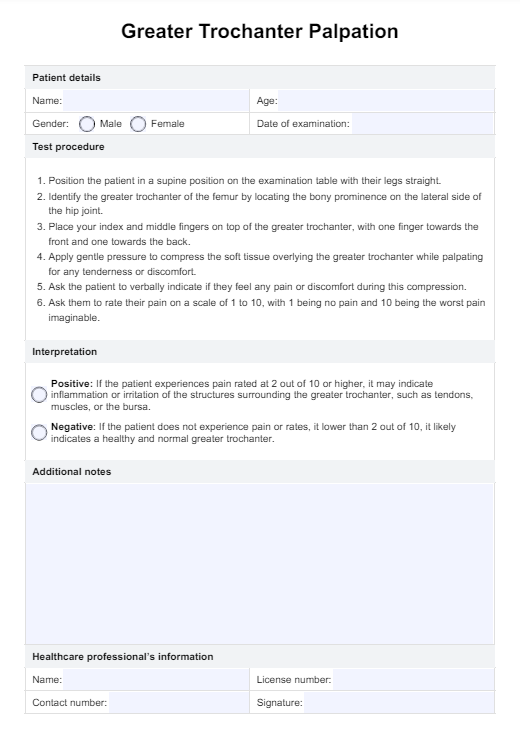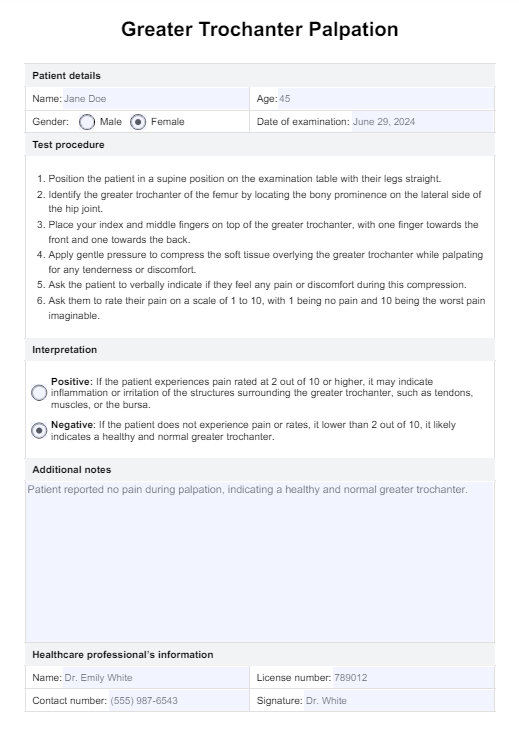Greater Trochanter Palpation
Learn how to perform the Greater Trochanter Palpation test to diagnose lateral hip pain. Download our free template now!


What is gluteal tendinopathy?
Gluteal tendinopathy is a condition in which the tendons of the gluteal muscles, specifically the gluteus medius and gluteus minimus, become irritated or inflamed. These muscles are essential for stabilizing the hip and pelvis, particularly walking, running, and standing.
This condition is closely associated with Greater Trochanter Pain Syndrome (GTPS), characterized by pain on the outer side of the hip. Understanding gluteal tendinopathy is crucial for accurate diagnosis and effective management to alleviate discomfort and improve function.
Symptoms of this type of tendinopathy
Gluteal tendinopathy, often associated with Greater Trochanteric Pain Syndrome (GTPS), manifests as persistent lateral hip pain. This condition predominantly affects the hip joint and can extend down the lateral aspect of the thigh. Patients frequently describe a deep aching pain that worsens with prolonged sitting, excessive hip adduction, or lying on the affected side - all of these are referred to as prolonged sitting pain.
Other common symptoms include pain during physical activities such as walking, climbing stairs, or standing up from a seated position. Individuals may also experience knee pain or leg length discrepancy in some cases, further complicating the condition.
Causes of this tendinopathy
The development of gluteal tendinopathy is multifactorial. The primary causes are repetitive stress or overuse of the hip abductor muscles, particularly the gluteus medius and minimus. Activities that involve excessive hip adduction, such as running or cycling, can worsen the condition.
Additionally, biomechanical issues like leg length discrepancy can lead to uneven stress on the hip abductors, contributing to the development of tendinopathy. Hip osteoarthritis and other degenerative conditions can also increase the risk, as can prolonged sitting, which places constant pressure on the lateral hip region.
Potential problems this may cause
If left untreated, gluteal tendinopathy can lead to significant functional impairments and chronic pain. The condition can severely limit mobility, challenging routine activities like walking, bending, or climbing stairs. Persistent pain can also lead to secondary issues such as sleep disturbances and mood disorders, including anxiety and depression.
In severe cases, the inflammation and degeneration of the tendons can cause partial or complete tendon tears, necessitating surgical intervention. Additionally, the altered gait pattern to avoid pain can result in compensatory issues in other joints, such as the knees and lower back.
Greater Trochanter Palpation Template
Greater Trochanter Palpation Example
What is the Greater Trochanter Palpation test?
The Greater Trochanter Palpation test is a diagnostic procedure used to identify tenderness and inflammation around the greater trochanter, a prominent bony landmark on the lateral aspect of the hip. This test is crucial for diagnosing conditions like greater trochanteric pain syndrome (GTPS) and gluteal tendinopathy.
How is this test conducted?
To conduct the Greater Trochanter Palpation test, the patient is usually positioned lying on their side with the affected hip facing upward. The healthcare provider then palpates the greater trochanter, applying light to moderate pressure using their fingers.
The patient is asked to report any pain or discomfort experienced during palpation. The test may be repeated with the hip in different positions to assess the extent and location of tenderness. It is essential for the examiner to differentiate between pain caused by palpation and that resulting from other hip movements or conditions. The examiner should then record their findings on the template found in our practice management system.
How are the results interpreted?
The Greater Trochanter Palpation test results are interpreted based on the patient's pain response. A positive test is indicated by localized pain or tenderness around the greater trochanter, suggesting inflammation or tendinopathy of the gluteal tendons.
The severity of the pain, its exact location, and accompanying symptoms are also considered. Additional diagnostic tests, such as imaging studies or functional assessments, may be required to confirm the diagnosis and rule out other potential causes of lateral hip pain.
How to use our Greater Trochanter Palpation test template
Our printable Greater Trochanter Palpation Test Template is designed to streamline the diagnostic process for healthcare providers. Download the template from our website and fill in the patient's details, including their pain history and physical examination findings.
The template includes sections documenting the palpation results, interpreting the findings, and outlining the recommended treatment plan. This standardized approach ensures consistency and accuracy in diagnosing and managing gluteal tendinopathy.
Common treatments for gluteal tendinopathy
Treatment for gluteal tendinopathy typically involves a combination of conservative measures and medical interventions. Initial management includes rest, activity modification, and physical therapy to strengthen the hip abductor muscles.
Nonsteroidal anti-inflammatory drugs (NSAIDs) may be prescribed for pain relief. In cases of persistent pain, a corticosteroid injection can be administered to reduce inflammation and provide temporary relief. Advanced treatments such as platelet-rich plasma (PRP) or shockwave therapy may also be considered.
Commonly asked questions
The greater trochanter palpation test is valuable for diagnosing conditions such as greater trochanteric pain syndrome (GTPS) and gluteal tendinopathy. It helps identify localized tenderness and inflammation around the greater trochanter.
The Greater Trochanter Palpation test is essential to a comprehensive hip examination. It can be seamlessly integrated into routine assessments to aid in diagnosing lateral hip pain conditions like GTPS and gluteal tendinopathy.
Complementary tests may include imaging studies (e.g., MRI or ultrasound) to visualize tendon pathology and functional assessments to evaluate hip strength and mobility. These additional tests can provide a better understanding of the patient's condition.

.jpg)




















-template.jpg)
















































































